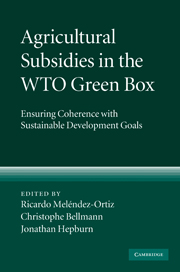Book contents
- Frontmatter
- Contents
- List of contributors
- Preface
- Acknowledgements
- List of abbreviations
- 1 Overview
- PART I The recent evolution of agricultural trade policy reform
- PART II The focus, extent and economic impact of green box subsidies
- 7 An analysis of EU, US and Japanese green box spending
- 8 Green box subsidies and trade-distorting support: is there a cumulative impact?
- 9 The distributional structure of green box subsidies in the European Union and France
- 10 The distributional structure of US green box subsidies
- PART III Green box subsidies and developing countries
- PART IV Green box subsidies and the environment
- PART V Looking forward: how can change take place?
- Appendix: Text of Annex 2 of the WTO Agreement on Agriculture (“the green box”)
- Index
- References
9 - The distributional structure of green box subsidies in the European Union and France
from PART II - The focus, extent and economic impact of green box subsidies
Published online by Cambridge University Press: 03 May 2010
- Frontmatter
- Contents
- List of contributors
- Preface
- Acknowledgements
- List of abbreviations
- 1 Overview
- PART I The recent evolution of agricultural trade policy reform
- PART II The focus, extent and economic impact of green box subsidies
- 7 An analysis of EU, US and Japanese green box spending
- 8 Green box subsidies and trade-distorting support: is there a cumulative impact?
- 9 The distributional structure of green box subsidies in the European Union and France
- 10 The distributional structure of US green box subsidies
- PART III Green box subsidies and developing countries
- PART IV Green box subsidies and the environment
- PART V Looking forward: how can change take place?
- Appendix: Text of Annex 2 of the WTO Agreement on Agriculture (“the green box”)
- Index
- References
Summary
Introduction
For the past 50 years, European agriculture has benefited from a Common Agricultural Policy (CAP) which aims to ensure food security (in terms of both quality and quantity) for consumers, to modernise the farming and agro-alimentary sector, to support farm revenue and, more recently, to take greater account of social concerns relating to the environment, land use, biodiversity and animal welfare. In pursuing these objectives, the CAP has three major principles: (i) market unity, which involves putting in place common administrative, health and veterinary regulations in all Member States, adopting identical prices between institutions and setting up a uniform customs tariff at the European Union's (EU) external frontiers; (ii) community preference, which encourages Member States lacking in certain products to give priority to obtaining supplies from a partner country (through taxing imports originating in third (non-EU) countries); (iii) financial solidarity, based on the premise that CAP agricultural expenses are shared, regardless of the agricultural specialisation of Member States.
The CAP has made it possible for agriculture within the community to develop and to move progressively from the deficit situation existing at the end of World War 2 (for the majority of temperate zone agricultural products) to a situation of surplus (Bureau, 2007). The EU, which is responsible for a quarter of all world agro-alimentary imports and exports, has become the largest actor in this sector, ahead of the United States (US).
- Type
- Chapter
- Information
- Agricultural Subsidies in the WTO Green BoxEnsuring Coherence with Sustainable Development Goals, pp. 258 - 303Publisher: Cambridge University PressPrint publication year: 2009
References
- 1
- Cited by



